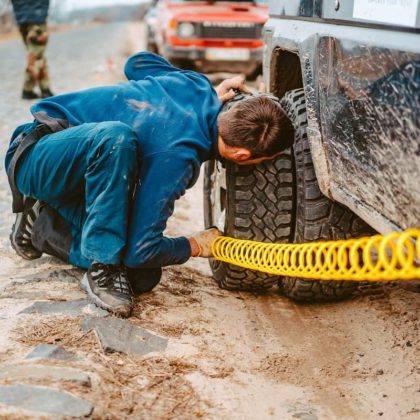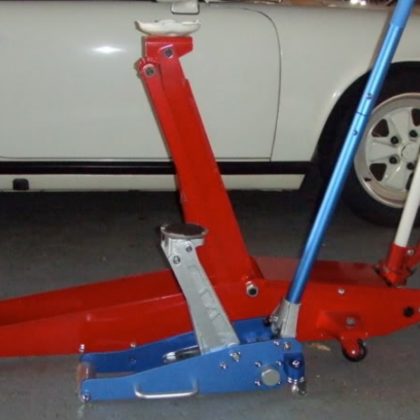If you regularly use tools in the course of your work, you need to have safe storage for them. A truck toolbox will come in handy when you drive to the job site. It provides a waterproof area and quick access to your wrenches and other tools.
Alternatively, you can throw the tools in the back of the truck on the bed. However, this would expose them to weather elements and also put them at the risk of getting lost. Instead of putting up with this hassle, consider installing a truck tool box if your truck doesn’t come with one.
The tool box is designed for anchoring on the truck’s bed to offer a secure and lockable space for your equipment.
The Installation Guide
This complete DIY installation guide will show you how to successfully install a truck tool box in your truck. The good thing with these steps is that they don’t require you to drill holes in your vehicle.
Tools Required
Before you set out installing the tool box, ensure you have the following tools to make your work easier.
- A pair of pliers or screwdrivers
- Padding material
- Work gloves
- Measuring tape
- Bolts, screws, nuts
- Protective gear
Don’t forget the toolbox itself, and once ready, here’s what to do.
Identify the Best Installation Location
The most important thing to do is to first measure the size of the tool box and the surrounding space. Carefully inspect the bed truck to find the perfect space for the box. Depending on your preference, this could be at the corner, front, or on one side.
The best location is where the lid of the tool box opens without experiencing or causing any obstruction.
Fit the Foam Padding
The foam padding plays multiple roles. First, it protects the truck cargo bay from any potential damage. When done correctly, it also helps maintain the paint job in good shape.
Take the measurements of the length of the box. This will help you know how much foam you need to line on the truck’s bed rail.
Take note that you can forgo this step if your truck features a bed liner. The liner will be adequate to protect your vehicle from any damages resulting from pressure by the tool box.
Align the Tool Box Properly
In this step, establish the position of the holes on your truck’s cargo bay. In most cases, they’re plugged with some rubber fittings just in case you won’t need them for anything.
Remove the plugs and align the box to these holes in a way you can fix the bolts or nuts.
It’ll be easier to align with the cover of the box open for easier viewing of the box’s bottom holes.
Fix the Bolts
When you’re satisfied with the alignment of the holes on the box and bed rails, screw them in position. Different trucks and boxes feature designs that vary from one vehicle to another.
For the box to be fixed in place firmly, you’ll need to use at least four to six bolts. Use the screwdriver or pair of pliers to tighten the bolts. You want to ensure the box doesn’t move out of position even on rough terrain, causing unsettling vibrations.
However, don’t use too much force as this may be counterproductive. You don’t want to damage the bed rails; neither do you want to tamper with the treads on the bolts.
Check That Everything Is Well Done
At this point, your installation process is as good as finished. Before you call it a day, though, it’s wise to examine the work done. First, lift the lid of the tool box to see if it opens without any problems.
Gently shake the box to see if it exhibits any problems like vibration or friction. Check to see that no bolts, nuts, or washers have been left lying around. If you’re satisfied with the state of things, your truck tool box is ready to use.
Tips for Tool Box Installation
You want the installation of your tool box to be successful. This will only happen if you’re cautious right from the beginning. It’s hence important that you choose high-quality tools and materials for the job.
The padding materials should be durable, and the tool box made from easy-to-maintain materials. The foam should also be of the same measurement as the tool box to cover the area adequately. As such, start by measuring the upper side of the tool box before buying the foam.
Similarly, ensure you buy high-quality bolts, nuts, and screws in the quantity you need to fit the tool box. Most of these materials are easy to get from local hardware stores.
When buying the bolts, look for those with special designs. Those that feature a nut resembling an aluminum block are a lot easier to hook to the rail. They also help hold the installation in place for a more extended period.
Ensure you inspect the tool box regularly. Proper maintenance includes cleaning and the removal of debris, dirt, and any mud present. Remember also to lubricate any moving parts accordingly.
Final Thoughts
Not having a place to keep your tools can be messy and also risky. Leaving them unattended exposes them to elements of weather and hastens their wear and tear. They also get lost easily and can fall in the wrong hands without your notice.
This is where a truck tool box comes in handy. If your truck doesn’t have one already, you can easily learn how to install a truck tool box. With the right tools and materials, the process shouldn’t be demanding.
Acquire the type of tool box you want for your truck. Depending on its size, buy a padding material to act as a shield for the truck’s bed rails. Install the box and securely fix it in place using bolts and nuts.
Remember that you don’t need to have any experience in this field to do a perfect job. The process should take you minimal effort to complete and won’t interfere with the integrity of your truck.



Comments
How To Measure Truck Bed: Steps to Follow | My Truck Needs This
[…] Trucks come in different sizes, which affects the size of the truck bed. The measurements of the truck bed are important as they determine how much cargo or equipment you can haul. Sometimes, you want to acquire some accessories for the truck bed, or you want to install a toolbox. […]